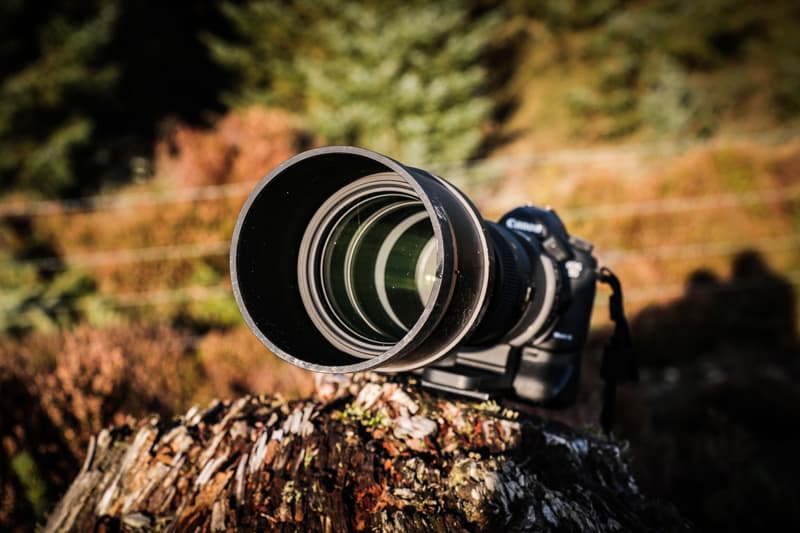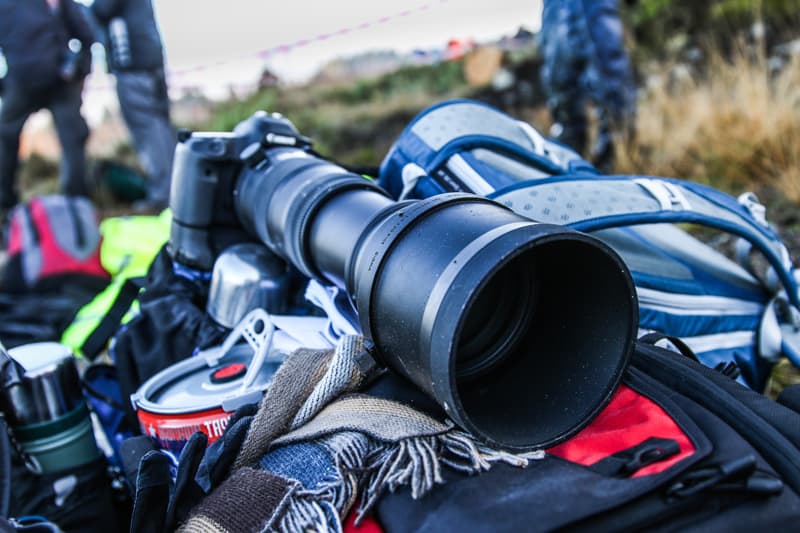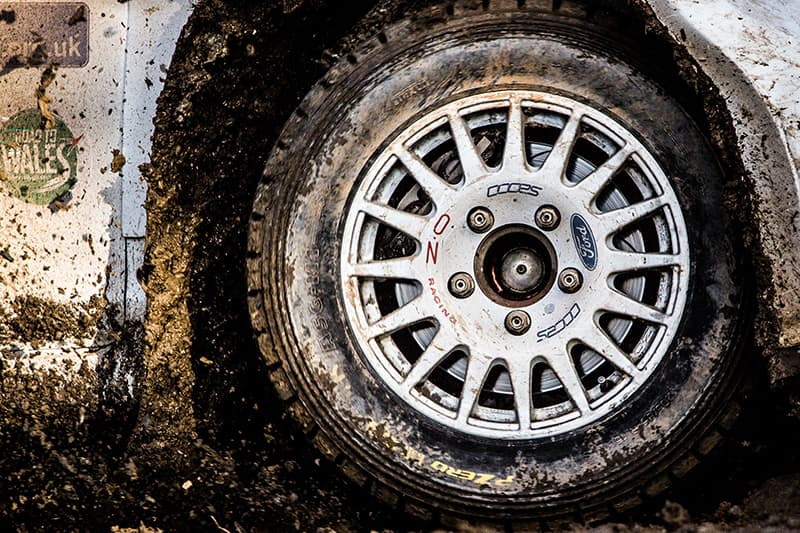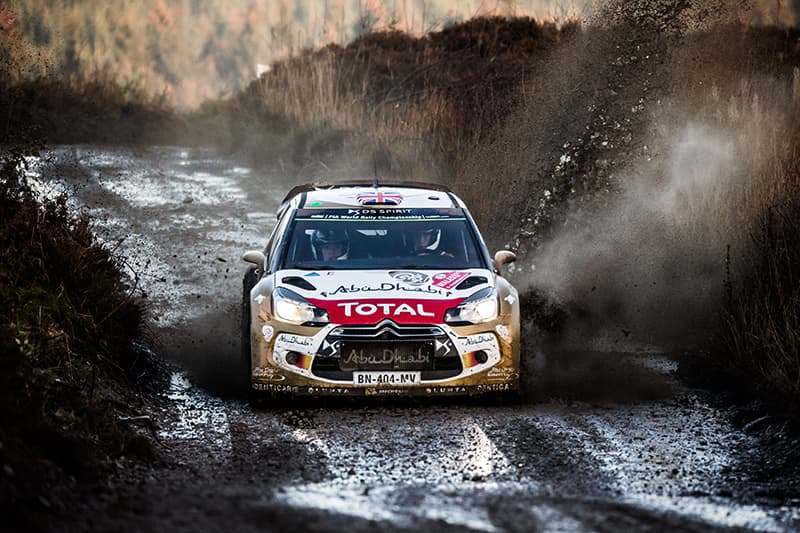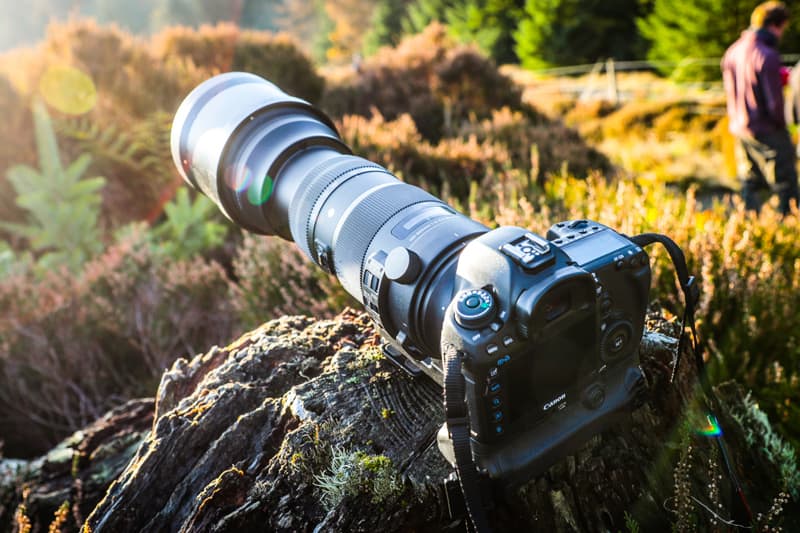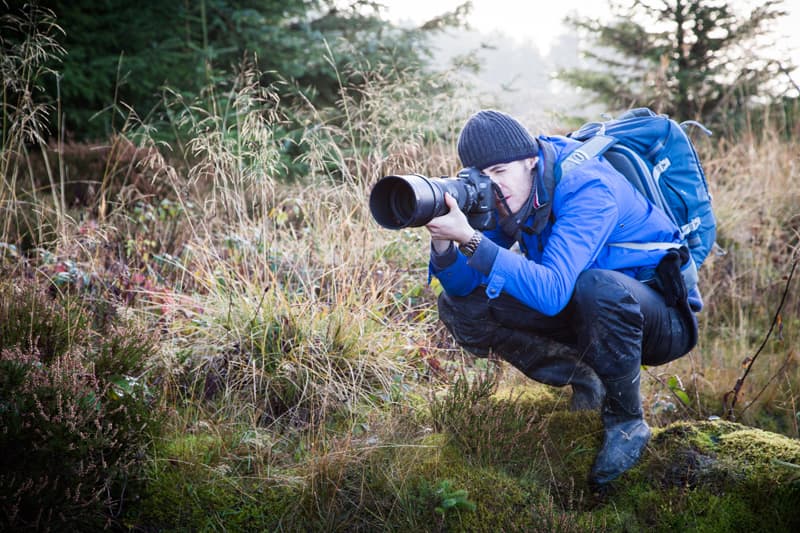As I put an order in for a bacon sandwich and try to overcome my disappointment at leaving my Thermos flask at home, I prepare for the day ahead and couple the brute that is the new Sigma 150-600mm f/5-6.3 DG OS HSM S to the front of my Canon EOS 5D Mark III. Anxious about resting the padded lens cover nose-down in thick mud, I crouch down, upturn the lens, and secure my Arca Swiss plate to the lens’s permanently attached tripod collar before returning the heavy combo to my backpack.
It’s bitterly cold and I’m shivering – not even the numerous layers and two pairs of socks I’m wearing seem to be helping. As I glance up to my left to observe the moon peering through the spruces of Clocaenog Forest deep in North Wales, I urge the sun to make an appearance to warm me up. An hour later, it finally emerges on the horizon as I navigate to a vantage point from which to photograph rally cars tearing through a water splash. The stage is set, I’m in position, and I can’t wait to start shooting one of my favourite motorsports with a lens I’ve been yearning to test since its launch in September.
Within moments of pulling the camera and lens out of my backpack, I’m on all fours, fingers searching through the mud, trying to find the tiny screw that dropped out of the lens hood as I loosened it ready to inverse and reattach it. Without this screw, I have no way of securing the large metal lens hood to the front of the lens, and no way of protecting the huge front element from damage as stones and debris are flung towards me. This is far from ideal – I can hear the first car approaching and if I don’t find the screw soon, I’ll have no option but to gaffer tape the hood on.
Just in the nick of time, my fingers somehow stumble upon it and I fasten the hood in a frantic panic. ‘You won’t want to risk removing that again today,’ an intrigued photographer beside me comments. True to his word, I didn’t. With no time to support the lens on my monopod, I resort to flicking the Optical Stabilizer to Mode 1 for general shooting and set the focus distance switch that’s positioned above to 10m to infinity, which will prevent the lens attempting to focus closer than I need.
With my 5D’s drive mode set to continuous, autofocus set to continuous (AI Servo) and Case 1 set as my AF sensitivity (the camera’s versatile multi-purpose setting) I knock back the lock switch that’s helped prevent the lens creep to full telephoto in the time its been carried over my shoulder. Supporting the lens with the tripod collar resting on the palm of my hand, I start to zoom in to compose my first shot.
The zoom ring operates in just over a quarter turn, but, supporting it the way I am, I’m finding that I have to twist the zoom ring in stages to get it from 150mm to 600mm – something I put down to the physical effort involved in moving such heavy optics across such a long focal length – the result of a complex internal construction made up of 24 elements in 16 groups.
Supporting it in my left hand just behind the lens hood is a much more comfortable way of holding the lens at full telephoto, and makes it feel better balanced and less front heavy. Pulling the front of the lens back towards the camera exploits the potential of being able to push/pull to zoom in and out, just as users of Canon’s EF 100-400mm f/4.5-5.6 L IS USM lens will be accustomed to. The difference here is that while it’s consistently smooth throughout the range, the push/pull mechanism of the Sigma requires considerably more effort. It is 1,480g heavier than the Canon after all.
As I set the zoom to 180mm to give myself every chance of freezing the action at the maximum aperture of f/5, I discover the lens closes to f/5.6 between 180mm-310mm and operates at f/6.3 thereafter up to 600mm. Locking the zoom ring reveals it can also be locked at 200, 250, 300, 400, 500 and 600mm, and I value the way this lock can be easily unlocked again with a sharp twist of the zoom ring or a sharp pull or push of the front of the lens, except for when it’s locked at 150mm.
As the first car screams into view, I squeeze the shutter and rattle out a burst of eight shots at 6fps. Of the eight shots I take, six are showing as sharp on the rear screen – not a bad 75 per cent success rate given the car was approaching head-on at a speed in excess of 60mph. But how does this AF speed compare? Is it quick?
A quick swap back and forth between the Sigma and Canon 100-400mm f/4.5-5.6 L IS USM – another telephoto that just so happens to be residing in my bag – reveals the Sigma is just as fast as the Canon in terms of its lock-on speed. That said, the Sigma isn’t entirely faultless and has sporadically hunted for focus a couple of times – most notably at times when I’ve focused at a long focal distance and then attempted to focus much closer, or vice versa. As for the sound of the AF, the lens goes about its business in a nigh-on silent manner, much like other Sigma lenses that utilise a Hyper Sonic Motor.
Three more cars pass by and I glance down at the lens to realise it’s already caked in splatters of mud. Though not such an issue today, its dust-proof and splash-proof construction will be particularly useful for the demands of professionals who find themselves shooting in the rain, while the addition of an oil-repellent coating on the forefront and rear lenses is designed to make it easier to clean, which I can’t fault as I give the huge front element another wipe with my lens cloth between shots.
Some users may want to add an extra layer of protection in the form of the UV WR filter, but the large 105mm filter thread means an additional expense of £159 – a price worth paying, I’d say, in order to keep it in pristine condition.
After 30 minutes of virtually non-stop shooting, handholding this 2.86kg monstrosity is taking its toll. I’m fighting a battle to keep the camera steady at 600mm and my arms are failing from fatigue. There’s little option but to pull out my monopod, which helps to take the weight off and lessens the risk of camera shake.
As the action continues, I’m interested to learn how well the lens is performing optically, and I soon find myself firing off a series of shots covering different focal lengths between the maximum aperture of f/5 and the minimum aperture of f/22.
Analysing the corners of the images on my MacBook highlights severe vignetting at 600mm throughout the aperture range. There’s less cause for concern at the wide end, with virtually all traces dispersing by f/8, but users will find themselves wanting to enable the relevant lens profile correction when Lightroom and Camera Raw supports it.
Chromatic aberrations are handled exceptionally well, but it’s the sharpness of the lens – noticeably so at the corners of images at both ends of the zoom when the lens is wide open – that impresses most. The optimum sweet spot is found around at f/8-f/11, after which sharpness gradually drops away beyond f/14.
A few hours later and after a long walk down the stage, I take to carrying the lens by its tripod collar. Loosening the collar via the large knurled knob and rotating it by 180 degrees reveals that it notches accurately into place every 90 degrees. With the collar upturned and with my hand wrapped around it, it’s taken all the weight off my shoulders and made it far more manageable to transport. When putting the lens down, I’ve also taken to resting it nose down on its hood, provided the ground is level. The hood even features a removable rubber ring at the tip to help cushion and protect it from damage – yet another example of the close attention to detail that’s been paid to this lens.
Sigma 150-600mm f/5-6.3 DG OS HSM S Field Test – Verdict
Apart from the somewhat nervous start, when I lost the screw out of the lens hood – which, in hindsight, would benefit from being captive and irremovable – my experience of using Sigma’s latest telephoto zoom in the sort of conditions it was designed for was extremely positive.
There’s no getting away from the fact that it weighs a ton, so you won’t last long using it handheld before you cry out for a set of sticks or a monopod, like I did. Autofocus is generally swift and reacted sharply to focusing on a high-speed subject.
The build quality is exemplary for use in the great outdoors by the enthusiasts and pros it’s out to target, while the sharpness of the final result doesn’t disappoint – just don’t expect distortion-free images straight out of the camera without having to apply lens corrections first.
This field test does leave one question unanswered, though: how does it compare to Tamron’s 150-600mm f/5-6.3 SP Di VC USD lens, which is £555 cheaper for essentially the same versatile focal range? There’s only one way to find out the answer, and that’s to call in its direct rival to run a head-to-head. Watch this space!

